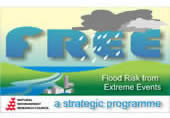Dataset Collection
Flood Risk for Extreme Events (FREE): Radiosonde, Wind Profiles Data and Model Output from the Exploitation of new data sources, data assimilation and ensemble techniques for storm and flood forecasting project
Abstract
The Exploitation of new data sources, data assimilation and ensemble techniques for storm and flood forecasting Project is a NERC Flood Risk for Extreme Events (FREE) Research Programme project (Round 1 - NE/E002137/1 - Duration January 2007 - April 2010) led by Prof AJ Illingworth, University of Reading. This project investigates possible methods of producing ensemble weather forecasts at high-resolution. These ensembles will be used with raingauge and river flow to improve methods of flood forecasting. The dataset includes radiosonde and wind profiles in England and Wales derived using Doppler radar returns from insects. The radial velocity measurements from insects were converted into VAD profiles by fitting a sinusoid to radial velocities at constant range. All measured profiles have been interpolated to the instrument location.
Model output files from experiments assimilating radial winds from insects are also available.
Floods in the UK are often caused by extreme rainfall events. At present, weather forecasts can give an indication of a threat of severe storms which might cause flash floods, but are unable to say precisely when and where the downpours will occur, due to the complex range of processes and space-time scales involved. The first stage is to predict the air motions leading to convergence and ascent at a certain location where the precipitation will be initiated, then the development of the precipitation needs to be forecast, and hydrological models used to produce accurate, quantitative, probabilistic flood predictions. Data assimilation is a sophisticated mathematical technique that combines observations with model predictions to give an analysis of the current state of the atmosphere. This analysis may be used to initialise a weather forecast. Although precipitation is well observed by weather radar, attempts to assimilate radar data have had little success; by the time the rain develops the forecast model state is too far from the truth and the air motions are inconsistent with the position of the first radar precipitation echo.
We propose to overcome this problem by assimilating new types of data from weather radars. These provide information on the evolving humidity fields and air motions in the lower atmosphere so that the model can accurately track the developing storm before precipitation appears. The model used will be a new Met Office model that can be run with a resolution (i.e., grid-spacing) of order 1-4km. This enables storm-cloud motions to be explicitly calculated, rather than treated as a sub-grid-scale effect. Furthermore, current operational forecast models are only updated with observations every few hours; in the new approach the model will be updated much more frequently. This should yield weather forecasts with improved locations (in space-time) for rainfall events.
Initialisation errors are not the only cause of inaccuracies in storm-scale weather forecasts. Models are often run only for a small region of the world, and the data on the boundaries of this area provided from a larger-scale model. These data are known as lateral boundary conditions. Errors in these lateral boundary conditions and modelling errors also contribute to the errors in the forecast. Even if these errors were reduced, the nonlinear nature of the storm dynamics ensures that there is a limit, beyond which the value of deterministic forecasts becomes questionable. After that point it becomes important to determine the uncertainties in the forecast precipitation, so an ensemble approach is required. (An ensemble is a collection of perturbed forecasts that may be considered as a statistical sample of the forecast probability distribution.)
The appropriate construction of a storm-scale ensemble is an open question. We propose a structured approach where perturbations will be designed on the basis of physical insight into convective forcing mechanisms. The resulting probabilistic rainfall forecasts can be interfaced to hydrological models used for flood forecasting. For the first time, this project will allow different scales of application of these methods to be supported: ranging from localised flash flooding of small catchments, through to indicative first-alert forecasting with UK-coverage and forecasting of river discharges to the sea. The project will also assess the impacts of improvements in numerical weather prediction on flood forecast performance.
In this project we anticipate fruitful interactions between the different disciplines of observations and measurement, meteorology and hydrology. Radar assimilation software development and ensemble forecasts will take place using Met Office models, so improvements can be implemented operationally very easily. The use of operational radars makes this project well placed to take advantage of data from any extreme events occurring during the period of the study.
Temporal Range
2007-06-18T23:00:00
2009-06-28T23:00:00
Geographic Extent
61.1101° |
||
-12.0000° |
4.4195° |
|
49.0000° |

